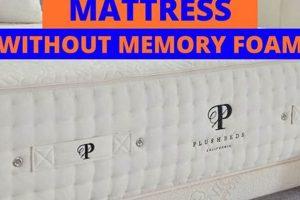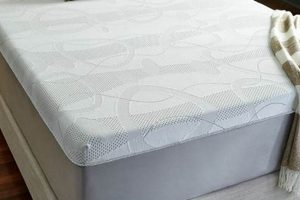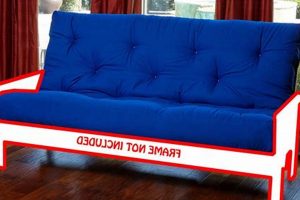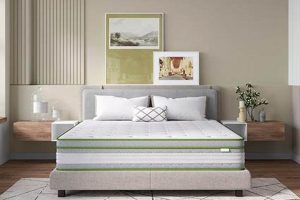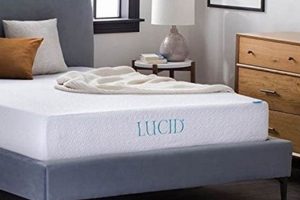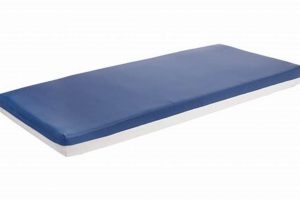A support structure designed specifically to accommodate viscoelastic mattresses is an integral component of a sleep system. It typically consists of a frame, often made of wood or metal, with slats or a solid surface on which the mattress rests. These supports differ in construction and materials from those used for innerspring mattresses due to the unique properties of memory foam, which requires even weight distribution and adequate ventilation to prevent sagging and maintain its structural integrity.
The appropriate support enhances the comfort and longevity of the viscoelastic mattress. It prevents premature wear and tear, ensures proper spinal alignment, and can improve airflow, mitigating heat retention. Historically, traditional box springs were common, but these are often unsuitable for memory foam due to their potential to damage the foam’s structure. Modern designs prioritize firm, level surfaces that provide consistent support across the entire mattress area, contributing to a more restful sleep experience.
This discussion will delve into the various types of suitable structures, examining the materials used in their construction, assessing the importance of proper ventilation, and outlining factors to consider when selecting the optimal base for this type of mattress. Furthermore, the potential impact on warranty validity will be explored.
Essential Considerations
Proper selection and utilization are vital for optimal performance and longevity. The following guidelines provide essential considerations to ensure the mattress performs as intended and maintains its structural integrity over time.
Tip 1: Verify Compatibility with Mattress Warranty. Consult the mattress manufacturer’s warranty documentation to determine the specific requirements for structural support. Utilizing an incompatible support may void the warranty.
Tip 2: Prioritize Solid or Slatted Platforms. Opt for a solid platform or a slatted base with slats spaced no more than a few inches apart. This provides consistent support across the mattress surface, preventing sagging and uneven wear.
Tip 3: Ensure Adequate Ventilation. If selecting a solid platform, consider one with ventilation holes. Memory foam can retain heat, and adequate airflow is crucial to regulate temperature and enhance sleep comfort. Slatted bases inherently offer better ventilation.
Tip 4: Inspect for Structural Integrity. Before placing the mattress, thoroughly inspect the support for any signs of damage, such as broken slats or a warped frame. Addressing these issues proactively prevents damage to the mattress.
Tip 5: Consider Adjustable Bed Frames. Viscoelastic mattresses are generally compatible with adjustable bed frames, allowing for customized sleep positions. Ensure the adjustable frame is rated for the weight of the mattress and occupants.
Tip 6: Check for Center Support. For larger mattresses, such as queen or king size, verify that the support structure includes a center support beam. This provides additional reinforcement and prevents sagging in the middle of the mattress.
Adhering to these guidelines ensures proper support, prolongs the lifespan of the mattress, and optimizes the overall sleep experience. Choosing the appropriate structural component is an investment in long-term comfort and mattress durability.
The following sections will elaborate on the potential consequences of using unsuitable components and provide recommendations for identifying high-quality options.
1. Support
The degree of support provided by a mattress’s base is paramount to its performance and longevity, especially in the context of viscoelastic mattresses. An inadequate or incompatible support structure can compromise the integrity of the foam, leading to premature wear and a diminished sleep experience.
- Even Weight Distribution
Memory foam conforms to the body, distributing weight across its surface. The base must provide consistent support to prevent localized pressure points and sagging. For instance, a slatted base with widely spaced slats can create unsupported areas, leading to uneven compression and accelerated degradation of the foam. Solid or closely spaced slats are generally preferred.
- Prevention of Sagging
Sagging is a common concern with viscoelastic mattresses, particularly larger sizes. The base must be robust enough to bear the combined weight of the mattress and its occupants without deformation. Center support beams are essential for queen and king-size structures to prevent sagging in the middle, which can negatively affect spinal alignment and sleep quality.
- Impact on Mattress Firmness
The firmness of the support structure influences the perceived firmness of the mattress. A softer base can make the mattress feel plusher, while a firmer base provides a more supportive feel. The support should align with individual preferences and postural needs to ensure optimal comfort and spinal alignment. Mismatched firmness can lead to discomfort and potential musculoskeletal issues.
- Warranty Implications
Many mattress manufacturers stipulate specific support requirements in their warranty agreements. Failure to adhere to these requirements, such as using an unsuitable base, can void the warranty. Thoroughly reviewing the warranty documentation is crucial to ensure compliance and protect against potential repair or replacement costs.
These considerations underscore the critical role of proper support in the functionality and lifespan of a viscoelastic mattress. Selecting a suitable base is an investment in the mattress’s performance and the user’s overall sleep health, directly impacting its long-term value and satisfaction.
2. Ventilation
Viscoelastic foam, known for its pressure-relieving qualities, tends to retain heat more than traditional innerspring mattresses. This characteristic underscores the critical need for adequate ventilation within the mattress system. The support structure directly influences airflow, and therefore, temperature regulation. A solid, impermeable base restricts air circulation, potentially leading to heat buildup and discomfort for the sleeper. Conversely, a slatted foundation or a platform with built-in ventilation features promotes airflow, dissipating heat and moisture, and contributing to a cooler, more restful sleep environment. For instance, individuals residing in warmer climates or those prone to night sweats benefit significantly from a well-ventilated structure.
The design of the base impacts not only comfort but also the long-term health of the mattress. Trapped moisture can create a breeding ground for mold and mildew, compromising the integrity of the foam and potentially leading to allergic reactions. Therefore, selecting
a foundation that facilitates air movement is a preventative measure against microbial growth. Real-world examples include perforated platforms and slatted bases constructed from breathable materials, which allow for continuous air exchange around the mattress, minimizing moisture accumulation.
In conclusion, the ventilation properties of a viscoelastic mattress base are not merely a comfort consideration but a crucial factor affecting sleep quality, hygiene, and the mattress’s lifespan. Prioritizing a well-ventilated support structure mitigates heat retention, minimizes moisture buildup, and contributes to a healthier and more durable sleep system. Selecting a base that facilitates air circulation is essential for users of viscoelastic mattresses, particularly those sensitive to temperature or residing in humid environments. This integration of ventilation directly addresses a common challenge associated with memory foam, ensuring a more comfortable and hygienic sleep experience.
3. Durability
The durability of a viscoelastic mattress relies heavily on the integrity of its support structure. The base absorbs the cumulative stress from nightly use, and its structural integrity directly influences the mattress’s longevity. A poorly constructed base can lead to uneven weight distribution, causing localized stress and premature degradation of the foam. For instance, a base made with low-quality wood or flimsy metal may warp or break over time, creating depressions that accelerate wear in specific areas of the mattress. The selection of robust materials and a well-engineered design is paramount for ensuring both the support structure and the mattress endure prolonged use.
The connection between the base’s durability and the mattress’s performance extends beyond mere physical support. A stable, durable base maintains the intended firmness and shape of the mattress, contributing to consistent comfort and spinal alignment. Conversely, a failing base can alter the mattress’s feel and support characteristics, potentially leading to discomfort and even exacerbating back pain. Concrete examples include reinforced steel frames with closely spaced slats or solid platforms constructed from high-density wood, which offer superior resistance to deformation and ensure consistent support over many years. These options minimize the risk of sagging and maintain the mattress’s structural integrity.
In conclusion, the durability of a viscoelastic mattress base is not merely an aesthetic consideration but a critical factor affecting its overall performance and lifespan. A robust and well-engineered support structure ensures even weight distribution, prevents premature wear, and maintains the mattress’s intended firmness and shape. Investing in a durable base is a practical measure that prolongs the mattress’s lifespan, preserves its comfort, and protects the user’s investment. The long-term value derived from a viscoelastic mattress is directly linked to the quality and durability of its support structure.
4. Warranty
The warranty associated with a viscoelastic mattress is often contingent upon using a compatible support structure. Mattress manufacturers typically specify the types of bases that are approved for use with their products, outlining minimum requirements for slat spacing, frame material, and overall support capacity. Non-compliance with these stipulations can void the warranty, leaving the consumer responsible for repair or replacement costs in the event of premature mattress failure. For instance, a mattress warranty might require the use of a solid platform or a slatted base with slats spaced no more than three inches apart. Using a base with wider slat spacing could lead to sagging and invalidate the warranty claim.
The reason for these warranty restrictions lies in the inherent properties of viscoelastic foam. Unlike traditional innerspring mattresses, memory foam relies on even weight distribution to maintain its shape and provide optimal support. An unsuitable base can create pressure points and uneven compression, leading to localized wear and tear. Furthermore, the warranty may also address the issue of ventilation. A solid, non-breathable base can trap moisture and heat, potentially leading to mold growth and premature degradation of the foam. Therefore, manufacturers often specify the need for adequate ventilation to maintain warranty validity.
Understanding the warranty requirements related to mattress bases is crucial for protecting the consumer’s investment. Before purchasing a viscoelastic mattress, it is essential to carefully review the warranty documentation and ensure that the chosen base meets the manufacturer’s specifications. Failing to do so can result in the loss of warranty coverage and the potential financial burden of replacing a prematurely worn mattress. Therefore, adherence to the warranty guidelines is a fundamental aspect of responsible mattress ownership and ensures that the product performs as intended for its expected lifespan.
5. Compatibility
The concept of compatibility is paramount when selecting a base for a viscoelastic mattress. The interaction between the mattress and its support structure directly influences comfort, longevity, and warranty validity. An incompatible base can compromise the mattress’s performance and lifespan, leading to dissatisfaction and potential financial loss.
- Weight Distribution and Support Surface
Memory foam requires a consistently flat and supportive surface to prevent sagging and uneven wear. Bases with widely spaced slats or protruding elements can create pressure points and unsupported areas, diminishing the mattress’s ability to conform to the body and distribute weight evenly. A solid platform or closely spaced slats are generally more compatible, ensuring uniform support across the entire mattress surface. Incompatibility manifests as premature sagging and discomfort.
- Ventilation and Material Breathability
Viscoelastic foam is known for retaining heat, and an incompatible base can exacerbate this issue. Solid, non-breathable surfaces impede airflow, potentially leading to overheating and discomfort. Slatted bases or platforms with ventilation holes promote air circulation, helping to dissipate heat and regulate temperature. Incompatible materials, such as plastic sheeting, can further restrict airflow. Adequate ventilation is crucial for a comfortable sleep environment and preventing moisture buildup within the mattress.
- Frame Dimensions and Mattress Fit
The dimensions of the base must precisely match the size of the mattress to ensure proper support and prevent shifting or overhang. An undersized base can leave portions of the mattress unsupported, while an oversized base can allow the mattress to shift and slide, creating instability. Precise dimensional compatibility is essential for maintaining the structural integrity of the mattress and providing a secure and stable sleep surface. Incompatibility is evident through visible overhang or instability during use.
- Adjustable Base Functionality
For individuals seeking adjustable bed functionality, compatibility with adjustable bases is a critical consideration. Not all bases are des
igned to accommodate the flexibility required for articulation. Incompatible bases may not allow for smooth and reliable adjustment, potentially damaging the mattress or the base itself. It is essential to verify that the mattress is specifically designed for use with adjustable bases to ensure proper functionality and prevent premature wear.
These facets of compatibility highlight the importance of careful consideration when selecting a base for a viscoelastic mattress. The wrong choice can lead to discomfort, reduced lifespan, and voided warranties. Thorough research and attention to detail are essential for ensuring optimal performance and long-term satisfaction with the sleep system.
6. Height
The height of a viscoelastic mattress base is a relevant factor influencing accessibility, aesthetics, and storage capacity. Considerations regarding height extend beyond mere personal preference, impacting ease of use and the overall functionality of the sleep environment.
- Accessibility and Ease of Entry/Exit
The combined height of the base and mattress dictates the overall bed height, directly affecting ease of entry and exit. Individuals with mobility limitations or those recovering from injuries may find a lower bed height more accessible, reducing the strain on joints. Conversely, taller individuals may prefer a higher bed height for greater comfort and ease of movement. Standard bed heights typically range from 18 to 25 inches, but the optimal height is subjective and dependent on individual physical characteristics and preferences. Inappropriate height can lead to discomfort or potential injury during entry or exit.
- Aesthetic Considerations and Room Proportions
The height of the base contributes to the overall visual appearance of the bed and its integration within the room’s design. A lower profile base can create a more minimalist and contemporary aesthetic, while a taller base can convey a more traditional or luxurious feel. The base height should be proportionate to the room’s dimensions to create a balanced and harmonious visual effect. For example, in a room with low ceilings, a lower base may be preferable to avoid overwhelming the space. Height contributes significantly to the room’s ambiance.
- Storage Capacity and Under-Bed Space
A taller base offers increased under-bed storage space, providing a practical solution for organizing and storing items such as bedding, clothing, or personal belongings. The amount of accessible storage space is directly proportional to the height of the base. Lower profile bases offer minimal or no storage, while taller platform bases or those with built-in drawers provide ample storage capacity. The availability of under-bed storage is particularly relevant in smaller living spaces where maximizing storage is a priority. Utilizing under-bed space optimizes functionality.
- Compatibility with Headboards and Footboards
The height of the base must be compatible with the design and dimensions of any accompanying headboard or footboard. A base that is too low may result in the headboard being disproportionately tall, while a base that is too high may obscure the headboard entirely. Careful consideration of the base height is essential for achieving a visually balanced and aesthetically pleasing bedroom ensemble. Precise measurements and design coordination ensure a harmonious and integrated appearance. Misalignment detracts from the overall design.
These considerations regarding height demonstrate its relevance to the overall functionality and aesthetics of the sleep environment. Selecting a base height that aligns with individual needs, preferences, and the room’s design contributes to a more comfortable, accessible, and visually appealing sleep space. The height of the base influences the user’s experience and the room’s ambiance.
7. Materials
The selection of materials in a viscoelastic mattress base directly influences its support capabilities, durability, and compatibility with the mattress itself. The properties of these materials determine the structure’s ability to evenly distribute weight, promote airflow, and withstand the stresses of long-term use, impacting the mattress’s performance and longevity.
- Wood Frames and Slats
Wood, particularly hardwood varieties such as oak or maple, provides a robust and stable framework for viscoelastic mattresses. Solid wood frames offer excellent weight-bearing capacity and resistance to deformation. Wood slats, when properly spaced, provide sufficient support while allowing for some degree of airflow. However, the type of wood and the quality of construction significantly impact the base’s durability. For instance, softwood slats may be prone to cracking or warping under pressure, compromising support and potentially damaging the mattress. Pressure-treated or kiln-dried wood enhances resistance to moisture and decay, prolonging the base’s lifespan. Wood’s inherent properties influence the mattress’s stability and lifespan.
- Metal Frames and Mesh
Metal frames, typically constructed from steel or aluminum, offer exceptional strength and durability. Steel frames provide superior weight-bearing capacity and resistance to bending or breaking, making them suitable for larger mattresses and heavier individuals. Metal mesh platforms, often used in conjunction with metal frames, provide a solid and supportive surface for the mattress. However, metal can be prone to corrosion or rust if not properly treated or coated. Powder-coated finishes offer protection against moisture and abrasion, extending the frame’s lifespan. The gauge and type of metal determine the frame’s ability to withstand stress and maintain its structural integrity. Metal ensures robust, long-lasting support.
- Upholstery Fabrics and Coverings
Upholstery fabrics, such as cotton, polyester, or blends thereof, serve as a protective layer over the base, enhancing its aesthetic appeal and providing a comfortable surface for the mattress. The choice of fabric impacts breathability and moisture absorption. Natural fibers like cotton promote airflow, while synthetic fabrics may be less breathable and more prone to trapping heat. Tight weaves offer greater resistance to wear and tear, prolonging the base’s lifespan. Additionally, some fabrics are treated with antimicrobial or stain-resistant finishes to enhance hygiene and ease of maintenance. Fabric selection influences comfort and hygiene.
- Composite Materials and Plastics
Composite materials, such as engineered wood or high-density plastics, offer a cost-effective alternative to solid wood or metal. These materials can be molded into complex shapes and offer varying degrees of strength and durability. Engineered wood, such as plywood or particleboard, provides a stable and consistent surface for the mattress, but its resistance to moisture may be limited. High-density plastics are lightweight and resistant to corrosion, but their load-bearing capacity may be lower than that of metal or solid wood. The composition and density of these materials determine their suitability for supporting a viscoelastic mattress. Composites provide versatility in design and cost.
These materials collectively determine the performance and longevity of a viscoelastic mattress base. The selection of appropriate materials is cruci
al for ensuring proper support, ventilation, and durability, all of which contribute to a comfortable and restful sleep experience. Informed choices regarding material composition can optimize the mattress’s performance and extend its lifespan.
Frequently Asked Questions
The following addresses common inquiries regarding the selection and utilization of mattress foundations for viscoelastic mattresses, providing clarity and guidance for optimal performance and longevity.
Question 1: What type of support is most suitable for a viscoelastic mattress?
Solid platforms or slatted bases with closely spaced slats are generally recommended. These structures provide consistent support across the entire mattress surface, preventing sagging and uneven wear. Avoid bases with widely spaced slats, as they can create pressure points and compromise the mattress’s integrity.
Question 2: Does the mattress require ventilation?
Yes, adequate ventilation is crucial for viscoelastic mattresses. Memory foam tends to retain heat, and a lack of airflow can lead to discomfort and moisture buildup. Slatted bases or platforms with ventilation holes promote air circulation, helping to regulate temperature and prevent microbial growth.
Question 3: Can a traditional box spring be used?
Traditional box springs are generally not recommended for viscoelastic mattresses. Their springy construction may not provide the necessary support and can potentially damage the foam’s structure. Consult the mattress manufacturer’s guidelines for approved support types.
Question 4: How do adjustable bed frames interact with viscoelastic mattresses?
Viscoelastic mattresses are generally compatible with adjustable bed frames, allowing for customized sleep positions. However, it is essential to ensure that the adjustable frame is rated for the weight of the mattress and occupants. Verify compatibility with the mattress manufacturer’s recommendations.
Question 5: What materials are ideal for a base?
Durable materials such as solid wood, steel, or high-density composites are generally preferred. These materials provide robust support and resistance to deformation. Ensure that the chosen material is treated or coated to prevent corrosion or moisture damage.
Question 6: How does the selection impact the mattress warranty?
Many mattress manufacturers stipulate specific support requirements in their warranty agreements. Using an incompatible base can void the warranty. Thoroughly review the warranty documentation and select a base that meets the manufacturer’s specifications.
Understanding these considerations is essential for making an informed decision and ensuring the proper care and maintenance of a viscoelastic mattress. Prioritizing compatibility and adhering to manufacturer guidelines will contribute to a more comfortable and durable sleep system.
The following section will address the process of choosing a suitable support and highlight factors to consider during the selection phase.
Conclusion
This exploration has underscored the critical role the foundation for memory foam mattress plays in optimizing performance, ensuring longevity, and maintaining warranty validity. The examination of support structures, materials, ventilation, and compatibility highlights the interconnectedness of these factors in achieving a comfortable and durable sleep environment. Informed decisions regarding the base are not merely aesthetic considerations but essential components of a well-functioning viscoelastic mattress system.
The long-term value derived from a memory foam mattress is directly proportional to the quality and suitability of its support. Prudent selection, guided by manufacturer specifications and an understanding of individual needs, represents a sound investment in sleep health and mattress durability. Responsible ownership necessitates a commitment to choosing a foundation for memory foam mattress that aligns with both the mattress’s requirements and the user’s preferences, ensuring years of restful and supported sleep.


